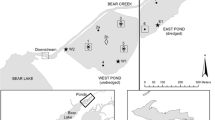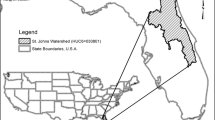Abstract
Simulation modeling with uncertainty analysis was applied to the question of nonpoint source pollution control through extensive wetland restoration. The model was applied to the Quanicassee River basin, a tributary stream to Saginaw Bay on Lake Huron in northeastern Michigan, USA. An estimate of the role of the existing 695 ha of riverside and lake-side wetlands in the lower Quanicassee River basin suggests that they retain 1.2 metric tons of phosphorus per year (mt P/yr), or 2.5% of the total phosphorus load from the basin. A simple Vollenweider-type model of phosphorus retention by created wetlands, calibrated with 3-years of data from two wetland sites in Midwestern USA, was used to estimate the effect of major wetland restoration in the basin. For a wetland restoration project involving 15% of the Quanicassee River basin or 3,120 ha of wetlands, an estimated 33 mt P/yr could be retained, assuming a proper hydrologic connection between the wetlands and the river. This would represent a reduction of two-thirds of the existing phosphorus load to the Bay from the Quanicassee River basin. Large-scale wetland restoration appears to be a viable management practice for controlling phosphorus and other nonpoint source pollution from entering Saginaw Bay. It is an alternative that meets two major resource goals – developing wetland habitat and controlling pollution to the Great Lakes.
Similar content being viewed by others
References
Arheimer, B. and Wittgren, H.B. 1994. Modelling the effects of wetlands on regional nitrogen transport. Ambio 23: 378-386.
Bouchard, R., M. Higgins and Rock, C. 1995. Using constructed-pond systems to treat agriculture runoff: A watershed perspective. Lake and Reservoir Managmt. 11: 29-36.
Brown, M.T. 1988. A simulation model of hydrology and nutrient dynamics in wetlands. Comput. Environ. and Urban Systems 12: 221-237.
Burton, T.M. and Prince, H.H. 1993. Wetland restoration in the coastal zone of Saginaw Bay: Annual report 1993. Department of Fisheries and Wildlife, Michigan State University, East Lansing, MI.
Chapra, S.C. 1979. Applying phosphorus loading models to embayments. Limnol. Oceanogr. 24: 163-168.
Christensen, N., Mitsch, W.J. and Jørgensen, S.E. 1994. A first generation ecosystem model of the Des Plaines River Experimental Wetlands. Ecol. Eng. 3: 495-521.
Debusk, T. and Merrick, P. 1989. Summary of operational and research data for the Reedy Creek Improvement District Wetland-Based Wastewater Treatment System (WTS2). Report of March 1989.
Diamond, P. and Hoffman, P. 1995. Extend - performance modeling for decision support. Imagine That, Inc., San Jose, CA.
Diaz, O.A., Anderson, D.L. and Hanlon, E.A. 1993. Phosphorus mineralization from histosols of the Everglades agricultural area. Soil Sci. 156: 178-185.
Fleischer, S., Stibe, L., Leonardson, L. 1991. Restoration of wetlands as a means of reducing nitrogen transport to coastal waters. Ambio 20: 271-272.
Fleischer, S., Gustafson, A. Joelesson, A., Johansson, C. and Stibe, L. 1994. Restoration of wetlands to counteract coastal eutrophication in Sweden. In:Mitsch, W.J. (ed.), Global Wetlands: Old World and New World. pp. 901-907. Elsvier, Amsterdam.
Haycock N.E., Pinay, G., Walker, C. 1993. Nitrogen retention in river corridors: European perspective. Ambio. 22: 340-346.
Heliotis, F, Vellidis, G. Bandacu, D. and Pringle, C. 1994. The Danube Delta: historical wetland drainage and potential for Restoration. In:Mitsch, W.J. (ed.), Global Wetlands: Old World and New World. pp. 759-767. Elsvier, Amsterdam.
Johnston, C.A. 1991. Sediment and nutrient retention by freshwater wetlands: effects on surface water quality. CRC Crit. Rev. Environ. Control. 21: 491-565.
Kadlec, R.H. 1997. An autobiotic wetland phosphorus model. Ecol. Eng. 8: 145-172.
Kadlec, R.H. and Hammer, D.E. 1988. Modeling nutrient behavior in wetlands. Ecol. Modell. 40: 37-66.
Kadlec, R.H. and Knight, R.L. 1996. Treatment Wetlands. Lewis Publishers, Boca Raton, Florida. 893 pp.
Kirchner, W.B. and Dillon, P.J. 1975. An empirical method of estimating the retention of phosphorus in lakes. Water Resources. Res. 11: 182-183.
Limno-Tech, Inc. 1995. A preliminary ecosystem modeling study of zebra mussels (Dreissena polymorpha) in Saginaw Bay, Lake Huron. Ann Arbor, MI.
Lowe, E.F., Battoe, L.E., Stites, D.L. and Coveney, M.F. 1992. Particulate phosphorus removal via wetland filtration: an examination of potential for hypertrophic lake restoration. Environ. Mgmt. 16: 67-74.
MDNR. 1988. Michigan Department of Natural Resources remedial action plan for Saginaw River and Saginaw Bay. MDNR Surface Water Quality Division, Great Lakes and Environmental Assessment Section, Lansing, MI.
Mitsch, W.J. 1988. Productivity-hydrology-nutrient models of forested wetlands. In:Mitsch, W.J., Straskraba, M. and Jørgensen, S.E. (eds), Wetland Modelling. pp. 115-132. Elsevier, Amsterdam.
Mitsch, W.J., Reeder, B. and Klarer, D. 1989. The role of wetlands for the control of nutrients with a case study of Western Lake Erie. In:Mitsch, W.J. and Jørgensen, S.E. (eds), Ecological Engineering: an Introduction to Ecotechnology. pp. 129-158. John Wiley and Sons, New York.
Mitsch, W.J. and Reeder, B.C. 1991. Modelling nutrient retention of a freshwater coastal wetland: estimating the roles of primary productivity, sedimentation, resuspension and hydrology. Ecol. Modell. 54: 151-187.
Mitsch, W.J. and Reeder, B.C. 1992. Nutrient and hydrologic budgets of a Great Lakes coastal freshwater wetland during a drought year. Wet. Ecol. Managmt. 1: 211-223.
Mitsch, W.J. and Gosselink, J.G. 1993. Wetlands. 2nd edn. Van Nostrand Reinhold, New York. 722 pp.
Mitsch, W.J., Wu, X. and Wang, N. 1993. Modelling of the Des Plaines experimental wetlands: an integrative approach to data management and ecosystem prediction. Report for USEPA Region V. Wetland Research Inc. Chicago, Illinois. 92 pp.
Mitsch, W.J., Reeder, B.C. and Robb, D.M. 1994. Modelling ecosystem and landscape scales of Lake Erie coastal wetlands. In:Mitsch, W.J. (ed.), Global wetlands: Old World and New. pp. 563-574. Elsevier, Amsterdam.
Mitsch, W.J. and Cronk, J.K., 1995. Influence of hydrologic loading on phosphorus retention and ecosystem productivity in created wetlands. Technical Report WRP-RE-6 U.S. Army Engineer Waterways Experiment Station, Vicksburg, MS. 84 pp.
Mitsch, W.J., Cronk, J.K., Wu, X., Nairn, R.W. and Hey, D.L. 1995. Phosphorus retention in constructed freshwater riparian marshes. Ecol. Appl. 5: 830-845.
Niswander, S.F. and Mitsch, W.J. 1995. Functional analysis of a two-year-old created instream wetland: hydrology, phosphorus retention, and vegetation survival and growth. Wetlands 15: 215- 225.
Oliver, J.D. and Legovic, T. 1988. Okefenokee marshland before, during, and after nutrient enrichment by a bird rookery. Ecol. Modell. 43: 195-223.
Omernick, J.M. and Gallant, A.L. 1988. Ecoregions of the Upper Midwest States. EPA/600/388-037, U.S. Environmental Protection Agency, Washington DC. 56 pp.
Paulson, G.A. 1993. The potential to integrate wetland restoration and water quality plans to reduce non-point source pollution problems of the nearshore waters of the Greater Lakes; a report to the Great Lakes Protection Fund. The Wetlands Initiative, Chicago, IL.
Paulson, G.A. 1994. Great Lakes wetland restoration project: linking wetlands restoration and water quality planning for the Great Lakes. The Wetlands Initiative, Chicago, IL.
Pearlstein, L., McKellar, H. and Kitchens, W. 1985. Modelling the impacts of a river diversion on bottomland forest communities in the Santee River floodplain, South Carolina. Ecol. Modell. 29: 283-302.
Phillips, J.D. 1989. Nonpoint source pollution control effectiveness of riparian forest along a coastal plain river. J. Hydrology 110: 221-237.
Phipps, R.L. and Applegate, L.H. 1983. Simulation of management alternatives in wetland forests. In:Jørgensen, S.E. and Mitsch, W.J. (eds), Application of Ecological Modelling in Environmental Management, Part B. pp. 311-339. Elsevier, Amsterdam.
Richard, C., Johnson, L. and Host, G. 1993. Landscape influence on habitat, water chemistry, and macroinvertebrate assemblages in Midwestern stream ecosystems. Report to USEPA Environmental Research Laboratory, Duluth, MN. Center for Water and the Environment, University of Minnesota, Duluth, MN.
Richmond, B. and Peterson, S. 1992. STELLA II: tutorials and technical documentation. High Performance Systems Inc., Lyme, New Hampshire. 196 pp.
SVSU. 1994. Saginaw Bay watershed: a strategy for wetland restoration. Saginaw Valley State University, Saginaw, Michigan.
Sather, J.H. (ed.), 1992. Intensive studies of wetland functions at the Des Plaines River Wetlands Demonstration Project. Wetlands Research, Inc., Chicago, Illinois.
Vitosh, M., Seamon M., and Hyde D. 1992. 1992 grid soil sampling project: Saginaw Bay watershed. Michigan State University, East Lansing, Michigan.
Vollenweider, R.A. 1975. Input-output models, with special reference to the phosphorus loading concept in limnology. Schweiz. Z. Hydrol. 37: 53-84.
Vollenweider, R.A. 1976. Advances in defining critical loading levels for phosphorus in lake eutrophication. Mem. Ist. Ital. Idrobiol. 33: 53-83.
Vollenweider, R.A. and Kerekes, J. 1980. The loading concept as a basis for controlling eutrophication: philosophy and preliminary results of the OECD programme on eutrophication. Prog. Water Technol. 12: 5-18.
Vollenweider, R.A., Rast, W. and Kerekes, J. 1980. The phosphorus loading concept and Great Lakes eutrophication. In:Loehr, R.C., Martin, C.S. and Rast, W. (eds), Phosphorus management strategies for lakes. pp. 207-234. Ann Arbor Science Publs., Ann Arbor, MI.
Vought, L.B.M., Pinay, G., Fuglsang, A. and Ruffinoni, C. 1993. Structure and function of buffer stripes from a water quality perspective in agricultural landscape. Landscape and Urban Planning 31: 323-331.
Wang, N. 1996. Modelling phosphorus retention in freshwater wetlands. Ph.D. Dissertation. The Ohio State University, Columbus, OH. 182 pp.
Wu, X. and Mitsch, W.J. 1998. Spatial and temporal patterns of algae in newly constructed freshwater wetlands. Wetlands 18: 9- 20.
Author information
Authors and Affiliations
Rights and permissions
About this article
Cite this article
Wang, N., Mitsch, W. Estimating phosphorus retention of existing and restored coastal wetlands in a tributary watershed of the Laurentian Great Lakes in Michigan, USA. Wetlands Ecology and Management 6, 69–82 (1998). https://doi.org/10.1023/A:1008451823394
Issue Date:
DOI: https://doi.org/10.1023/A:1008451823394




